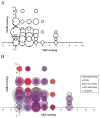Carbonic anhydrase IX as an imaging and therapeutic target for tumors and metastases
- PMID: 24146382
- PMCID: PMC4282494
- DOI: 10.1007/978-94-007-7359-2_12
Carbonic anhydrase IX as an imaging and therapeutic target for tumors and metastases
Abstract
Carbonic anhydrase IX (CAIX) which is a zinc containing metalloprotein, efficiently catalyzes the reversible hydration of carbon dioxide. It is constitutively up-regulated in several cancer types and has an important role in tumor progression, acidification and metastasis. High expression of CAIX generally correlates with poor prognosis and is related to a decrease in the disease-free interval following successful therapy. Therefore, it is considered as a prognostic indicator in oncology.In this review, we describe CAIX regulation and its role in tumor hypoxia, acidification and metastasis. In addition, the molecular imaging of CAIX and its potential for use in cancer detection, diagnosis, staging, and for use in following therapy response is discussed. Both antibodies and small molecular weight compounds have been used for targeted imaging of CAIX expression. The use of CAIX expression as an attractive and promising candidate marker for systemic anticancer therapy is also discussed.
Figures






Similar articles
-
Carbonic anhydrase IX (CAIX) as a mediator of hypoxia-induced stress response in cancer cells.Subcell Biochem. 2014;75:255-69. doi: 10.1007/978-94-007-7359-2_13. Subcell Biochem. 2014. PMID: 24146383 Review.
-
Carbonic anhydrase IX: regulation and role in cancer.Subcell Biochem. 2014;75:199-219. doi: 10.1007/978-94-007-7359-2_11. Subcell Biochem. 2014. PMID: 24146381 Review.
-
Carbonic anhydrase IX induction defines a heterogeneous cancer cell response to hypoxia and mediates stem cell-like properties and sensitivity to HDAC inhibition.Oncotarget. 2015 Aug 14;6(23):19413-27. doi: 10.18632/oncotarget.4989. Oncotarget. 2015. PMID: 26305601 Free PMC article.
-
Hypoxia and metabolic phenotypes during breast carcinogenesis: expression of HIF-1alpha, GLUT1, and CAIX.Virchows Arch. 2010 Jul;457(1):53-61. doi: 10.1007/s00428-010-0938-0. Epub 2010 Jun 5. Virchows Arch. 2010. PMID: 20526721
-
Lowered oxygen tension induces expression of the hypoxia marker MN/carbonic anhydrase IX in the absence of hypoxia-inducible factor 1 alpha stabilization: a role for phosphatidylinositol 3'-kinase.Cancer Res. 2002 Aug 1;62(15):4469-77. Cancer Res. 2002. PMID: 12154057
Cited by
-
Trefoil factor family 2 protein: a potential immunohistochemical marker for aiding diagnosis of lobular endocervical glandular hyperplasia and gastric-type adenocarcinoma of the uterine cervix.Virchows Arch. 2019 Jan;474(1):79-86. doi: 10.1007/s00428-018-2469-z. Epub 2018 Oct 15. Virchows Arch. 2019. PMID: 30324235
-
A DNA-encoded chemical library based on chiral 4-amino-proline enables stereospecific isozyme-selective protein recognition.Nat Chem. 2023 Oct;15(10):1431-1443. doi: 10.1038/s41557-023-01257-3. Epub 2023 Jul 3. Nat Chem. 2023. PMID: 37400597
-
Design, synthesis, and molecular docking studies of N-substituted sulfonamides as potential anticancer therapeutics.J Taibah Univ Med Sci. 2023 Nov 4;19(1):175-183. doi: 10.1016/j.jtumed.2023.10.006. eCollection 2024 Feb. J Taibah Univ Med Sci. 2023. PMID: 38047237 Free PMC article.
-
Promise of hypoxia-targeted tracers in metastatic lymph node imaging.Eur J Nucl Med Mol Imaging. 2022 Nov;49(13):4293-4297. doi: 10.1007/s00259-022-05938-y. Eur J Nucl Med Mol Imaging. 2022. PMID: 35994060 No abstract available.
-
A minimal hybridization chain reaction (HCR) system using peptide nucleic acids.Chem Sci. 2021 May 6;12(23):8218-8223. doi: 10.1039/d1sc01269j. Chem Sci. 2021. PMID: 34194712 Free PMC article.
References
-
- Supuran CT. Carbonic anhydrases: novel therapeutic applications for inhibitors and activators. Nat Rev Drug Discov. 2008;7:168–181. - PubMed
-
- Supuran CT. Carbonic anhydrase inhibitors. Bioorg Med Chem Lett. 2010;20:3467–3474. - PubMed
-
- Okamoto N, Fujikawa-Adachi K, Nishimori I, Taniuchi K, Onishi S. cDNA sequence of human carbonic anhydrase-related protein, CA-RP X: mRNA expressions of CA-RP X and XI in human brain. Biochim Biophys Acta. 2001;1518:311–316. - PubMed
-
- Picaud SS, Muniz JR, Kramm A, Pilka ES, Kochan G, Oppermann U, Yue WW. Crystal structure of human carbonic anhydrase-related protein VIII reveals the basis for catalytic silencing. Proteins. 2009;76:507–511. - PubMed
-
- Saczewski F, Innocenti A, Brzozowski Z, Slawinski J, Pomarnacka E, Kornicka A, Scozzafava A, Supuran CT. Carbonic anhydrase inhibitors. Selective inhibition of human tumor-associated isozymes IX and XII and cytosolic isozymes I and II with some substituted-2-mercapto-benzenesulfonamides. J Enzyme Inhib Med Chem. 2006;21:563–568. - PubMed
Publication types
MeSH terms
Substances
Grants and funding
LinkOut - more resources
Full Text Sources
Other Literature Sources

